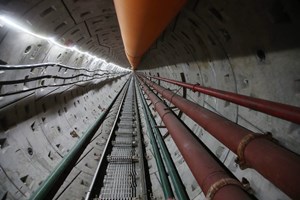Construction of 339-mile power line begins in New York City
ALBANY, N.Y. (AP) — Construction has begun on an underground electrical transmission line that will bring Canadian hydropower to New York City as part of an effort to make the Big Apple less reliant on fossil fuels, state officials announced Nov. 30.
Once complete, the Champlain Hudson Power Express will stretch 339 miles (546 km) through New York state to deliver power produced by the company Hydro-Québec.
Authorities project the line will deliver enough clean energy to power more than one million homes while also cutting carbon emissions by 37 million metric tons, equivalent of taking more than half a million cars off the road annually.
"As construction begins on this project to help deliver clean energy to New York City, our state is setting yet another example of what climate action looks like," New York Governor Kathy Hochul said Wednesday. She called the transmission line "a monumental step toward protecting our environment and creating family-sustaining, green jobs in both upstate and downstate New York."
Although New York is no stranger to renewable resources like solar farms and hydro dams, it can be challenging to deliver power south to New York City. The transmission line, which is scheduled to be finished in 2026, would run beneath Lake Champlain and the Hudson River and along existing highways as it makes its way south.
The state has set a goal of having 70% of its electricity powered by renewable resources by 2030. Transmission lines, which move power from where it is generated to where it is consumed, are crucial to that effort, the project's backers said.
"You look at some of the other resources like offshore wind and solar, those resources are absolutely going to help the state achieve its goal, but a lot of those have to get built," said Donald Jessome, the chief executive officer of Transmission Developers, which is spearheading the project.
While the state's move towards accessing more clean energy is one environmental advocates support, they still express concern about potential ramifications to wildlife, since parts of the transmission line will run through rivers.
"We're very much in support for renewable energy," said Tracy Brown, the president of environmental group Riverkeeper, "But we remain concerned about the impact on the Hudson. If the cable does go forward, being laid into the Hudson River as planned, we're calling for the root to be in the center of the river, as far from the margins where there are important habitats for wildlife."
Brown said it's important for the construction to minimize harm to the river species in the Hudson, which are already vulnerable.
Transmission Developers, who spent about a decade planning this project, will begin construction near Whitehall, an upstate New York village about 79 miles (127 km) north of Albany.
Related News
From Archive

- Glenfarne Alaska LNG targets late-2026 construction start for 807-mile pipeline project
- U.S. water reuse boom to fuel $47 billion in infrastructure spending through 2035
- $2.3 billion approved to construct 236-mile Texas-to-Gulf gas pipeline
- Major water pipe break in Puerto Rico hits over 165,000 customers
- Potomac River Tunnel project enters construction phase beneath Washington, D.C.
- Pennsylvania American Water launches interactive map to identify, replace lead water service lines
- Trump's tariffs drive $33 million cost increase for Cincinnati sewer project
- Utah city launches historic $70 million tunnel project using box jacking under active rail line
- Tulsa residents warned after sewer lines damaged by boring work
- Fatal trench collapse halts sewer construction in Massachusetts; two workers hospitalized




Comments